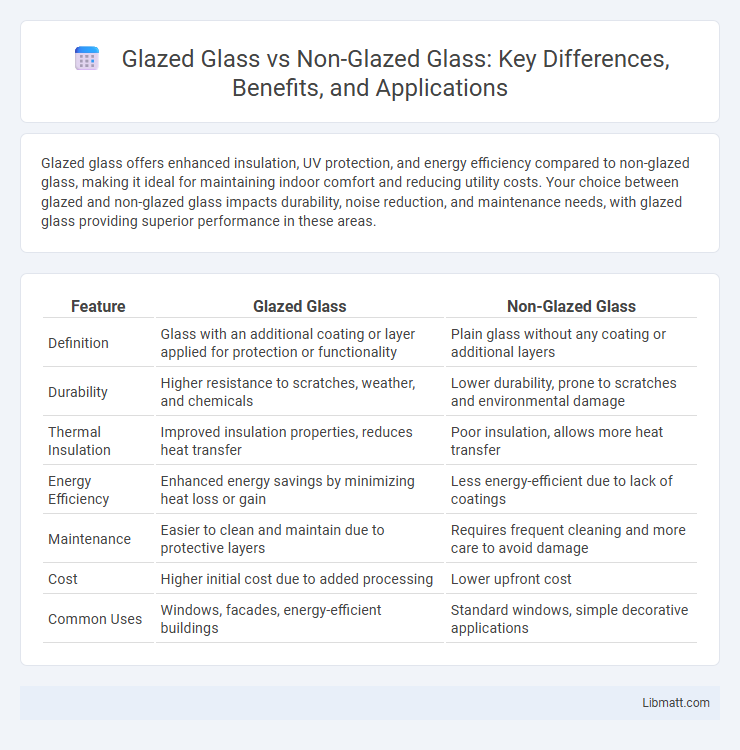Glazed glass offers enhanced insulation, UV protection, and energy efficiency compared to non-glazed glass, making it ideal for maintaining indoor comfort and reducing utility costs. Your choice between glazed and non-glazed glass impacts durability, noise reduction, and maintenance needs, with glazed glass providing superior performance in these areas.
Table of Comparison
| Feature | Glazed Glass | Non-Glazed Glass |
|---|---|---|
| Definition | Glass with an additional coating or layer applied for protection or functionality | Plain glass without any coating or additional layers |
| Durability | Higher resistance to scratches, weather, and chemicals | Lower durability, prone to scratches and environmental damage |
| Thermal Insulation | Improved insulation properties, reduces heat transfer | Poor insulation, allows more heat transfer |
| Energy Efficiency | Enhanced energy savings by minimizing heat loss or gain | Less energy-efficient due to lack of coatings |
| Maintenance | Easier to clean and maintain due to protective layers | Requires frequent cleaning and more care to avoid damage |
| Cost | Higher initial cost due to added processing | Lower upfront cost |
| Common Uses | Windows, facades, energy-efficient buildings | Standard windows, simple decorative applications |
Introduction to Glazed and Non-Glazed Glass
Glazed glass features a smooth, coated surface that enhances durability, weather resistance, and insulation, making it ideal for windows and architectural applications. Non-glazed glass lacks this coating, resulting in higher permeability and less protection from environmental factors. Understanding the differences helps you select the right type for energy efficiency, aesthetic appeal, and functional requirements.
Composition and Manufacturing Process
Glazed glass features an additional coating or layer, often made from materials like ceramic or metallic oxides, applied during or after the base glass manufacturing process to enhance properties such as insulation and durability. Non-glazed glass consists solely of raw or heat-treated glass without this surface treatment, maintaining its natural composition primarily of silica, soda ash, and limestone melted at high temperatures. Understanding this distinction in composition and manufacturing helps you choose the right glass type for specific thermal, aesthetic, or protective needs.
Key Differences Between Glazed and Non-Glazed Glass
Glazed glass features a smooth, reflective coating that enhances insulation, weather resistance, and aesthetic appeal, making it ideal for windows and decorative surfaces. Non-glazed glass lacks this coating, resulting in a raw, untreated surface that is more susceptible to damage, weather effects, and reduced thermal efficiency. The key differences lie in durability, energy efficiency, and maintenance requirements, with glazed glass offering superior performance in temperature regulation and protection against external elements.
Energy Efficiency and Insulation Properties
Glazed glass significantly improves energy efficiency by reducing heat transfer, thereby maintaining indoor temperatures and lowering heating and cooling costs. Its multiple layers and sealants provide superior insulation properties compared to non-glazed glass, which allows more heat to pass through and offers minimal thermal barrier. For your home or office, choosing glazed glass enhances comfort and energy savings year-round.
Visual Appearance and Aesthetic Impact
Glazed glass offers a sleek, reflective surface that enhances natural light while providing a polished, modern aesthetic ideal for contemporary architecture. Non-glazed glass typically appears matte or slightly frosted, delivering a more understated, utilitarian look that suits industrial and rustic settings. Your choice between glazed and non-glazed glass significantly influences the ambiance and visual appeal of your space.
Durability and Maintenance Requirements
Glazed glass offers superior durability due to its protective coating that resists scratches, moisture, and weathering, extending the lifespan of windows and doors. Non-glazed glass requires more frequent cleaning and maintenance to prevent surface damage and is more susceptible to chip and crack under harsh conditions. Choosing glazed glass reduces long-term maintenance costs and enhances structural integrity in both residential and commercial applications.
Cost Comparison: Glazed vs Non-Glazed Glass
Glazed glass typically costs more than non-glazed glass due to its added layers and specialized coating that enhance insulation and durability. Non-glazed glass offers a more affordable option but lacks the energy efficiency and noise reduction benefits of its glazed counterpart. Your choice depends on budget priorities and the long-term savings glazed glass provides through improved thermal performance.
Environmental Impact and Sustainability
Glazed glass typically offers better thermal insulation, reducing energy consumption for heating and cooling compared to non-glazed glass, which can lead to a lower carbon footprint over time. Non-glazed glass often requires more frequent replacement and can contribute to higher waste generation due to its lower durability and insulation efficiency. Choosing glazed glass for your projects supports sustainability by enhancing energy efficiency and reducing overall environmental impact.
Best Applications and Use Cases
Glazed glass is ideal for applications requiring enhanced thermal insulation, soundproofing, and weather resistance, such as in windows, doors, and storefronts where energy efficiency and durability are critical. Non-glazed glass suits interior uses like picture frames, tabletops, or decorative panels where protective coatings and insulation are less important. Your choice between glazed and non-glazed glass should align with the specific environmental conditions and functional requirements of your project.
Conclusion: Choosing the Right Glass Type
Glazed glass offers enhanced insulation, durability, and aesthetic appeal, making it ideal for energy-efficient buildings and modern designs. Non-glazed glass provides a cost-effective option with a minimalist look, suitable for interior partitions and temporary installations. Your choice depends on balancing budget, performance needs, and project goals to ensure optimal functionality and style.
glazed glass vs non-glazed glass Infographic

 libmatt.com
libmatt.com